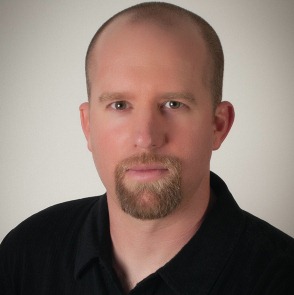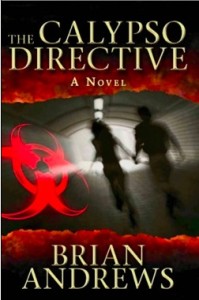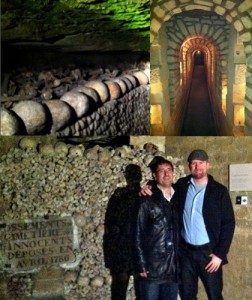From the ITW Debut Author class of 2012-2013, TKZ welcomes Brian Andrews as our guest blogger, here to discuss one of my favorite topics, researching location. Enjoy.
 Everyone has heard the old real estate adage, "What are the three most important factors to consider when buying property? LOCATION, LOCATION, LOCATION. As a thriller writer, I spend a great deal of time mulling over location… scene location to be precise. Why? Because selecting a scene location is like deciding whether to bake brownies using oil, or substituting applesauce instead. Sure, the applesauce brownies are low fat, but they lose that authenticity that makes a brownie taste like a brownie. Wikipedia is applesauce. The queasy, weak in the knees sensation I felt leaning against the metal railing on the Key Bridge, as I imagined what it would be like to jump into the grey-green water of the Potomac River flowing eighty feet below… that’s baking brownies with oil.
Everyone has heard the old real estate adage, "What are the three most important factors to consider when buying property? LOCATION, LOCATION, LOCATION. As a thriller writer, I spend a great deal of time mulling over location… scene location to be precise. Why? Because selecting a scene location is like deciding whether to bake brownies using oil, or substituting applesauce instead. Sure, the applesauce brownies are low fat, but they lose that authenticity that makes a brownie taste like a brownie. Wikipedia is applesauce. The queasy, weak in the knees sensation I felt leaning against the metal railing on the Key Bridge, as I imagined what it would be like to jump into the grey-green water of the Potomac River flowing eighty feet below… that’s baking brownies with oil.
When I travel for my "day job", I’m always scoping out locations for future scenes in future novels. My motto has become: Don’t force a location into the story, take the story to the location. Recently, I had a business meeting in Paris, which afforded me one free morning to play tourist. When my Parisian host asked me what I would like to do, I replied, "Take me to the creepiest place imaginable." And so he did. The Catacombs beneath Paris hold the remains of over six million Parisians. The walkways are lined with bones. Femurs and skulls are stacked 2 meters high and used to decorate this dank and disturbing underground labyrinth. It was described to me as "romantic macabre." No arguments there. When I finally stepped out of the Catacombs and back into the warm Parisian sun, I knew with certainty that characters of mine will someday find themselves in this location.
What is your favorite scene location in a novel, or in real life?
 Midwest born and raised, Brian is a US Navy Veteran who served as an officer aboard a 688 class nuclear submarine in the Pacific. Brian lives in Tornado Alley with is wife and daughter. His debut thriller, THE CALYPSO DIRECTIVE, was recently released. Brian is a member of the ITW debut author class of 2012/2013 and lifelong fan of the thriller genre.
Midwest born and raised, Brian is a US Navy Veteran who served as an officer aboard a 688 class nuclear submarine in the Pacific. Brian lives in Tornado Alley with is wife and daughter. His debut thriller, THE CALYPSO DIRECTIVE, was recently released. Brian is a member of the ITW debut author class of 2012/2013 and lifelong fan of the thriller genre.
Say hello to Brian on Facebook at: www.brianandrewsauthor.com/facebook


Welcome to TKZ, Brian! I’m putting the Catacombs on my “must see” list for my next trip to Paris–they sound wonderfully strange! I would love to set something in Avignon. Years ago, when my best friend and I were doing a post-grad tour of Europe, we hopped off the train at Avignon having no idea where we were. It was nighttime, and the old walled City of Popes was brightly lit. It looked like something out of a medieval fantasy story. As we walked around we almost expected to bump into knights or women with hair in crespinettes!
Brian, welcome! While Wikipedia and the internet in general are valuable background tool, I don’t believe that anything beats a “boots on the ground” tour of a potential location. You have to have all five senses in the mix to get the true feel for a place.
Welcome, Brian, and congrats on the debut.
One of our leading thriller authors once said, “When in doubt, make it up.” The audience laughed, but I recall Lawrence Block never left NY when writing about Tanner in Eastern Europe. He even had a typo in a MS, the “tobbo shops” in Czechoslovakia (it was supposed to be tobacco shops). But it sounded good, so he left it in. He laer got letters from people who “remembered those lovely little tobbo shops.”
Seriously, there is first hand and then there is no hand. Lee Child spoke at CraftFest this year, about setting a Reacher in Georgia, to which he has never been. Maybe it’s a matter of selective details PLUS the same sensations everyone feels.
Hi Brian, thanks for dropping by TKZ. I look forward to reading THE CALYPSO DIRECTIVE. I used the Paris Catacombs as one of the scenes in THE PHOENIX APOSTLES and found it to be a most interesting and frightening place, which made it perfect for my thriller. My buddies, the PJ Parrish sisters, also used the Catacombs in their terrific novel THE KILLING SONG. It’s just too good (and creepy) a location to pass up.
I agree with Joe H. that boots on the ground is the best way to research. But it can be cost prohibitive with books like mine that “globe trot”. I have placed my characters in scenes that in real life are inaccessible, and have had to rely on the Internet for some of my research such as scenes taking place in North Korea, Cuba, and the Secret Archives of the Vatican.
In my thriller THE LAST SECRET, I had a series of scenes take place in Axum, Ethiopia at a church claiming to be the current location of the Ark of the Covenant. I was able to locate a number of blogs written by backpackers who spent a lot of time in Axum and described in detail the landscape, local people and their dress and customs, food, tastes, smells, legends and history. Many of the blogs included extensive photos. Sprinkling in a few of those real details added to the depth of the scene. And all it took was digging deep into those Google search results.
The good news is we all have those Internet resources within a mouse click or two. Between travel blogs, Google Earth and Maps, Realestate.com, Wikipedia,and scores of other informative sites, we can come close to having our readers use all their senses like Joe mentioned.
Good luck with your debut thriller.
Welcome, Brian!
I agree with Bell. As a reader, I’m not too terribly impressed with the knowledge of location as I am with a writer’s ability to place me in the scenes. It doesn’t matter where these scenes are to me. It matters more how I experience them.
My favorite places:
Fishing docks at the marina
Airport
Hotel lobbies
Library
River bank
Busy boardwalk
State fair
My least favorite places:
Dark alley
Restaurant
Prison
The desert
The beach
Welcome, Brian. I was a thriller debut author in 2007-2008. Great program offered by ITW. I love creepy atmospheric places & researching them. Remembering to write a scene with all the senses in mind is important to me too. Good luck with your debut launch.
I’ll second Joe Moore’s comment about other resources, Google Earth/Maps in particular. Next best thing to being there, to coin a phrase.
I discovered Google’s street-level-view feature several years ago when I needed to place a set of scenes in my WIP in Winston-Salem, NC, but didn’t have the time/cash to travel there. While the scenes were eventually removed for other reasons, finding that park with the creek running through it under Silas Creek Road made those scenes blossom and was a real eye-opener.
When I had to replace those scenes and redo the climax in Raleigh, even though I’d been there before, “driving” around downtown Raleigh via Google Earth gave me the setting details I needed. And Google Earth has tool to let you select the day of the year and the time of day and see what the lighting would be like then for any location. Extremely cool–and helpful, too. Not as good as being there and hearing/smelling/feeling/tasting (?) the place, and of course you can’t (yet?) get inside buildings–or catacombs!–but better than not being there at all.
I write stories about the Cold War in Africa and Southern Asia. Personal travel and experiences provide the locations for most of the stories.
Heart, Afghanistan is my favorite real life location. I passed through there in 1973. Herat was perhaps the last pre-industrial city before the Soviets later bombed the hell out of it. I still have a leather pouch purchased in a shop described in one of my stories.
Kisangani, Zaire (Congo) is my least favorite real life location. I had the misfortune to visit the place in 1977; fortunately, we were only robbed twice. It too is the location for a chapter in one of my stories.
The Congo River in Joseph Conrad’s Heart of Darkness is my favorite location in a novel.
Joe Moore has it right; travel blogs and Google Earth are valuable research aids. I use Google Earth to map out my protagonist’s fictional travels and operations. It is also a good source of pictures for certain remote locations. When I was in Afghanistan, I never had a chance to go up to the Salang Pass. Google Earth provided me with an almost ground level perspective and enabled me to pick out a good spot for one of my characters to ambush the KGB bad guy.
The internet is also a good research tool for finding moon phases, like on October 4, 1980 in the middle of the Sahara desert. Likewise, weather information is sometimes available. It is also a good source to check to see if your memory of a place is correct. I had to make a change in a story involving the Indian Ocean beach on Lamu Island, Kenya. I remembered an offshore reef. Google Earth and maps available on the internet proved me wrong. Guess I was too busy watching the French girls run around topless in the surf to pay strict attention to detail.
Howdy Brian! So true the difference between hands on/feet on the ground research. I enjoy doing a lot of the research for my books which, as they are military thrillers, involves frequent trips to the shooting range with my friends who have Class 3 firearms permits. Writing about shooting machine guns, high powered rifles, and silenced pistols is so much easier when you’ve had your hands on them for a few hundred rounds.
Location travelling on the other hand is a lot more difficult, especially as it’s not really wise to travel to war torn towns in Africa or central Europe or military dictatorships like Myanmar and North Korea. That’s where the value of the web is exponentially highest.
That, and having access to a time machine / teleportation machine. My cousin Leonard being willing to go forth with his helmet cam and do my live research for me keeps me out of harm’s way so there is no problem getting accurate research. After a recent trip to Chechnya 1995 though his research fee unexpectedly increased from a 6-pack of Guinness to a 12-pack and a bottle of Bushmills. He also inexplicably now requires me to buy him a new pair of boxers after every trip. Apparently his alcoholism has caused bowel control problems.
Brian, great post! And great to hang with you last week with our debut author group at ITW.
I agree with some of the others here – give me something new. Not a cliche with a dark alley or prison. Give me a sunshiney spot I would never think something dreadful could happen in – and then do it and make me ask “Oh, no, that did not just happen there, did it?” And I have to go back and read it again. Robert Browne is doing this to me right now in his book The Paradise Prophecy.
Much success to you! Hope to meet up at another ThrillerFest in the future.-Donna
Brian, apparently I was signed in as my husband on the above comment! Congrats again – Donna
Great comments… thanks for the warm welcome everyone! Also, a big thanks to Joe for this opportunity to guest post on TKZ.
First of all, let me say I’m on the same page with ya’ll regarding dangerous and inaccessible locations. As a dad with toddlers at home, I’m not going to be doing location scouting in the third world anytime soon. I’m strictly a first world on location guy at the moment. Basil is on to something with tapping into his cousin’s military/travel experiences. As a former naval officer, I have called up several old Navy buddies who have completed tours in Afghanistan and Iraq to hear first hand accounts of their experiences.
Regarding Google Earth… what an amazing tool! When I scout a location, record video and take pictures, but invariably I miss some critical angle or change my mind later about a character’s position or movement within a scene. Google Earth is a life saver because I can go back and fill in the gaps. In CALYPSO, I have a chase scene in Vienna that starts at the Hotel Sacher. I spent an afternoon walking the character’s movements, but then a year later when I was actually writing the scene, I realized I had not taken any pictures looking at the Opera House across the street. Google Earth allowed me view the entire block as if I was back in Vienna. We are so lucky as authors to have these internet resources available today that were not available to authors for all of recorded history. It is amazing that we can shrink the entire world into the palm of our iPhone cradling hands.
Another great thing about being a fiction writer is that we have free license to make up stuff. I enjoyed the Afterward of Daniel Silva’s audiobook of The Messenger, when he talks about fans writing him about how to find “this location” or “that restaurant” in the Caribbean. He said he could not help but chuckle because he made most of them up. In my second novel, I am planning to set the finale in a convention center, but I have not been able to find a convention center anywhere in the world that has a specific architectural feature that I want to exploit… so, I’m going to tailor a fictional convention center to meet my specifications!
Yet, despite everything I said above, nothing beats being on location. Last night I took my first walk down Beale Street in Memphis. If you’ve never been, I promise that Google Earth can not touch the first person experience: the hot, humid summer air on my skin, the aroma of smokey BBQ cooking in back alley kitchens, beer being poured at street window bars into plastic solo cups, ten year old boys doing back handsprings down the street for a buck, and live musicians playing Johnny Cash all around me…